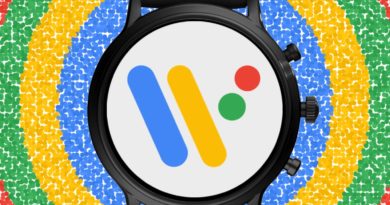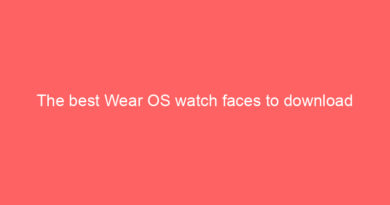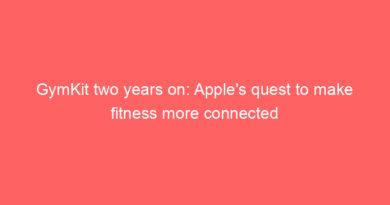Apple Watch Series 6 review: The best may not be the right choice
The Apple Watch Series 6 will go down as a minor leap forward in the story of Apple’s market-defining smartwatch.
While the Apple Watch has shown rivals the way, there’s a bit of catch up being played here. The addition of SpO2 brings the Apple Watch’s spec sheet in line with the likes of Fitbit, but new colors and finishes make up for a lack of new features.
We’ve already reviewed the new Apple Watch SE, which now feels like the mass appeal Apple smartwatch. So where does that leave the Series 6? Read on to find out.Price, rivals and context
The Apple Watch Series 6 is a direct replacement for the Series 5, and starts at the same price point of $399.99. It’s undercut by the all-new Apple Watch SE, which starts at $279. The SE misses out on ECG, SpO2 and most importantly the always-on display.
When it comes to Apple Watch alternatives, the Samsung Galaxy Watch 3 offers a round-faced option at the same price point with similar features. The Fitbit Sense also packs plenty of health features, although it’s nowhere near as good a smartwatch.
If cost is an issue, then the Huawei Watch GT2e ($129.99) impresses, but also look to the Garmin Venu Sq ($199.99) for a great mix of health features, battery life and sports tracking.
Design
A key reason to choose the Apple Watch Series 6 over the Apple Watch SE are the colors and finishes.The SE only comes in aluminum, which is the cheapest material. And you only get to choose from silver, grey or gold.The Series 6 comes in aluminum too, but also stainless steel which has a much higher quality finish. And then there are new Series 6 exclusive colors. We reviewed the stainless steel in gold, which co-ordinates with my gold wedding ring. But there’s also blue, PRODUCT(red) and graphite to choose from, joining the silver, grey and rose gold shades.And if you really want to splash the cash, there are ceramic and titanium versions too.The stainless steel Series 6 is a noticeable cut above the Apple Watch SE, and it’s great there’s now more choice of colors.However, appearance-wise everything else is the same as Series 5 and SE. It retains the upgraded shape introduced at Series 4, and uses the same screen tech and quality. There’s the same digital crown, used to scroll through menus and summon the menu screen.Like Series 5, there’s an always-on display, which you don’t get on the Apple Watch SE. This is probably the biggest mass appeal feature that would draw people to the more expensive Series 6.While not a Series 6 feature, there’s been a big new focus on Apple Watch faces in watchOS 7, so there’s a substantial new bunch to choose from if you haven’t used that before.Health and fitness trackingOn the Series 6, the headline addition is the SpO2 sensor, which tracks blood oxygen by shining a red LED under the skin to track the color of your blood. It joins ECG as a feature exclusive to the Series 6, and another reason to spend the extra $120 over the Apple Watch SE.
SpO2 is tracked automatically through the day and night, and you can spot check from the Blood Oxygen app on the Series 6. It’s a short, 15 second test with a nice animation, and you’ll find the results tucked in the respiratory section of Apple Health.
It works fine, and we had no reason for any concern over accuracy. The data lined up nicely against a medical grade SpO2 finger sensor we tried it against.
We did find it more difficult to obtain a manual reading than we have on any other device, with the Apple Watch warning it couldn’t get an accurate reading. We had to shift the Series 6 further up our arm each time.
You can see how the Apple Watch displays blood oxygen (and ECG/VO2 Max) below.
Blood oxygen is worth keeping an eye on, as drops during sleep can be a sign of a sleep disorder. And with the COVID pandemic still ongoing, blood oxygen has been in the spotlight.
But taking manual readings isn’t really the best use of SpO2, and the fact the Apple Watch tracks it automatically, and during sleep, makes it one of the better integrations we’ve seen.
Apple hasn’t used this data to inform any medical outcomes, like it has with Afib detection via its ECG monitor. It won’t suggest you get checked out for sleep apnea, nor does it measure breathing rate, or use SpO2 for any other measure than the saturation in your blood.
Apple has launched three health studies – for asthma, flu and respiratory illness, and heart disease – based on data from this sensor, so there’s every chance the Series 7 will use SpO2 to alert you to all kinds of conditions. But right now, unless you specifically want this data in your life, it’s a small piece of the overall puzzle.
ECG
As we mentioned, the Series 6 still has ECG capability to track Afib heart rhythms – just like the Series 5. And it can alert you to high/low heart arrhythmias, too.Resting heart rate is tracked on the Heart app on the watch itself, and that data is available in Apple Health.The high/low heart rate detection is a superb life-saving tool, and proof that wearing your smartwatch could save your life.And while the same can be said of ECG, it’s something we’ve used a handful of times in a year with the Series 5. That’s thankfully because we don’t suffer with a heart condition, but like SpO2, we increasingly feel that these are features many people will opt out of in favor of the cheaper Apple Watch SE. Health stats and featuresThe fitness tracking element of the Apple Watch is still top notch. The activity rings are a major part of the daily experience, and incredibly motivating. It’s always been a smart choice that Apple Watch demoted steps in favour of the Move ring, which is based on active calories burned. Calories is something that everyone can understand, is easily mentally linked to shedding weight, and automatically adjusts to your fitness level. It’s a good system.
The friends challenges are also superb, with the calorie burn algorithms making it a fair fight between people of differing fitness, so fitter people have to work harder to earn points.
The Apple Watch Fitness app (formally known as Activity) has been revamped as a one-stop-shop for fitness tracking and workout data. But health data including sleep and heart rate goes into Apple Health – it’s a little convoluted to be honest, and it would be nice just to see everything in one place.
The Fitness app shows steps, exercise, stand time, cardio fitness (VO2 Max), stand minutes per hour, running pace and walking pace as trends. An arrow shows whether you’re improving or declining, and you can tap to see your averages over the last year, although sadly, not longer than that.
This is also where the Fitness+ service will live when it launches.
Sleep tracking
But for the first time, sleep tracking joins the Apple Watch thanks to watchOS 7.Now, this isn’t exclusive to Series 6, and can be found even on the Series 3. So we’re simply echoing here what we’ve already written in our Apple Watch SE review.
It’s nowhere near as detailed or data heavy as you’ll find on Fitbit or other rivals. But there is enough to improve your sleep.
Apple’s sleep tracking will offer a summary of how long you slept, showing dark and light periods for any time you woke up in the night.
However, there’s a bigger focus on consistency, time in bed and time asleep.
Consistency is crucial for improving sleep, and the Bedtime feature on iPhone goes hand-in-hand with the Apple Watch’s tracking. That puts your iPhone and Apple Watch into a do not disturb state before bed, reminding you it’s time to hit the hay. And that does the extra work of keeping the Apple Watch screen dark while you’re in bed.
In the Apple Health analysis, it shows your preferred bedtime as a baseline against the time you actually fell asleep, so it’s possible to make improvements to your routine.
But while sleep tracking is now a core feature, it’s very much in the background. There’s no sleep goal ring, and sleep is logged deep in the Apple Health app.
You can check your last sleep duration and your consistency in the Bedtime app on Apple Watch itself. But if you didn’t know Apple Watch tracked sleep, you’d be forgiven for missing it entirely.
Workout tracking
In watchOS 7 there are more workout modes than ever, with dance and functional fitness added to the Workout app.
The Apple Watch is still a superb workout and fitness companion.
There’s loads to love: GPS that doesn’t require standing around to lock-on is still amazing, the heaps of workout modes are great, there are third-party apps including Strava plus accurate heart rate and offline music on the wrist thanks to Apple Music – it’s very easy to recommend.
But those that take their workouts really seriously will still find the Series 6’s limits.
While watchOS 7 now tracks VO2 Max, there aren’t the same training insights you’ll get on a Garmin. And battery life on GPS will struggle to last a whole marathon if you don’t turn something off.
And if you choose to use the Workout app, those used to the detail of ecosystems like Strava will be disappointed by the detail on offer. It’s impossible, for instance, to deep dive into your session to see things like max HR. That’s why we still use the Strava app for running.
Also, if you take your iPhone out for a run the Apple Watch will use the smartphone’s GPS to save battery, which can lead to accuracy issues.
The Series 6 does add a continuous altimeter, which is great for climbers and hikers, so you can see your elevation change in real time. And that will go hand-in-hand with the Blood Oxygen app so you can check how your body is coping with altitude. But we’d say that if you require this kind of data, a Garmin Fenix 6 or Instinct Solar are far better suited sports devices given the battery life.
At-home workouts are also great using Apple Watch. It can be used as part of Zova and Fiit workouts as a sensor, and Apple is launching Fitness+ which is totally reliant on the Apple Watch for heart rate tracking, which appears on screen.
With that in mind, it’s a good job that the Apple Watch still features the best optical sensor we’ve tested.
Heart rate monitoring and biometrics
We’ve extensively tested the Apple Watch, and found the optical sensor to offer a good experience. Compared to a chest strap, it’s been spotless for all of our steady and tempo runs and workouts.And when we tried to break the sensor with rapid 30 second intervals, we found it still fairly reliable, tracking surges in bpm all the way up to 190bpm, leaving rivals such as the Fitbit Sense in the dust. Yes, it lags a chest strap, and in rest periods it took longer to see our heart rate drop. But many rivals simply crap out with the movement and speed of HIIT sessions, while the Apple Watch doesn’t.As you can see below, a run tracked on the Apple Watch against a chest strap only showed 1bpm different across a 40 minute session that included fast intervals. Both tracked heart rate into the 190bpm range from a standing start – and in real time, the Apple Watch kept up with the chest strap. An impressive performance.
We also found the VO2 Max estimations to be more accurate than most devices, presented in the newly revamped Fitness app.We have a good handle on our VO2 Max level based on historic lab tests. And the Apple Watch Series 6 was certainly in the right ballpark. Smartwatch featuresIf you’re looking for the most comprehensive health features then choosing between Apple Watch and Fitbit Sense is a tough call to make.And as a sports watch, Garmin’s Forerunner and Fenix watches still lead the way.
But as a smartwatch, the Apple Watch is almost unparalleled.
Notifications are bread and butter, and delivered superbly.
Then you have Apple Pay which is still a leader in contactless payments, with almost total support for banks in supported countries, and a seamless experience.
The App Store is brimming with Apple Watch apps, and the quality has improved dramatically. The S6 chip is more than capable of powering demanding apps, and we’ve seen Google Maps re-join the platform.
If you’re into Apple services then you have support for Apple Music, and you can have playlists sync onto the smartwatch – the same as you can for podcasts. We’d say this needs revamping as the process is pretty fiddly, but users of Apple One will get plenty of value from the Apple Watch.
No other smartwatch can boast this level of service support. Wear OS has just canned its music streaming service. Fitbit Pay doesn’t support our major global bank. Garmin’s apps are barely that.
But this is also true of the Apple Watch SE. The Series 6 doesn’t offer anything extra in this regard – which is why we concluded the Apple Watch SE is better for more people.
Battery life
While no other smartwatch can touch the Apple Watch as a smartwatch, battery life is its Achilles heel. And it’s becoming an uncomfortable problem.
We got way more than the 18 hours stated by Apple, with closer to 36 hours at a time including a 45 minute workout.
But there are plenty of smartwatches, such as the Huawei Watch GT 2 Pro (10 days) and Fitbit Sense (six days) that now set the bar of what we expect from a smartwatch. And the Apple Watch Series 6 struggles to stack up.
It’s sleep tracking that really upsets things. The routine of nightly charging was acceptable, but now we need to find time to charge, and are having to create new routines. Ensuring we have charge is now something we actively think about – and that’s a bit wrong.
The faster charging does help. Zero to full in 90 minutes does make a difference, so we can generally pop the Apple Watch on its charger when we get out of bed, and it’s ready for the day when it’s time to leave the house (or work at home in these crazy pandemic times).
That said, we feel that the pressure of battery anxiety will be even more acute when the world returns to normal.
Apple Watch Series 6
By Apple
The Apple Watch Series 6 is the best version of the best smartwatch in the world. But it might not be the right device for you. The classier materials, new colors and always-on display are key reasons to buy, as are ECG and SpO2 for those looking for a health watch. But the Apple Watch SE feels easier to recommend, while those concerned about the single day battery life can now find good devices away from Apple.
SpO2 and ECG
New colors
The best version of the best smartwatchWatch SE suits more people
Single day battery life
Sleep tracking is basic


